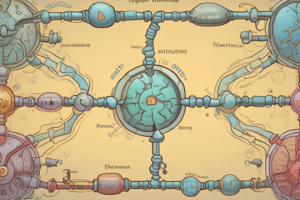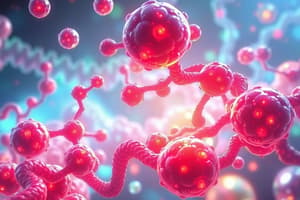Podcast
Questions and Answers
What is the primary physiological role of serotonin?
What is the primary physiological role of serotonin?
- Hormone production
- Pain regulation (correct)
- Cell division
- Muscle contraction
What is the rate limiting step in the biosynthesis of catecholamines?
What is the rate limiting step in the biosynthesis of catecholamines?
- DOPA degradation
- Tyrosine hydroxylation (correct)
- Epinephrine synthesis
- Norepinephrine storage
What triggers the release of epinephrine and norepinephrine?
What triggers the release of epinephrine and norepinephrine?
- High cholesterol levels
- Relaxation and sleep
- Fright, exercise, and low glucose levels (correct)
- Sustained fasting
Which enzyme is responsible for the oxidative deamination of catecholamines?
Which enzyme is responsible for the oxidative deamination of catecholamines?
What substance results from the decarboxylation of histidine?
What substance results from the decarboxylation of histidine?
What is the primary function of porphyrins in the human body?
What is the primary function of porphyrins in the human body?
Which substance is a precursor for the biosynthesis of porphyrins?
Which substance is a precursor for the biosynthesis of porphyrins?
What inhibits the enzyme ALA synthase in the biosynthesis of porphyrins?
What inhibits the enzyme ALA synthase in the biosynthesis of porphyrins?
Where in the body is the major site of heme biosynthesis?
Where in the body is the major site of heme biosynthesis?
What is the product formed when uroporphyrinogen III undergoes decarboxylation?
What is the product formed when uroporphyrinogen III undergoes decarboxylation?
What is formed during the initial step of heme degradation?
What is formed during the initial step of heme degradation?
How long is the typical lifespan of a red blood cell (RBC)?
How long is the typical lifespan of a red blood cell (RBC)?
What is the role of ALA dehydrase in porphyrin biosynthesis?
What is the role of ALA dehydrase in porphyrin biosynthesis?
What is the primary function of Bilirubin glucuronyl transferase in the liver?
What is the primary function of Bilirubin glucuronyl transferase in the liver?
Which condition is NOT a type of jaundice mentioned?
Which condition is NOT a type of jaundice mentioned?
Which compound is primarily responsible for regenerating ATP during intense muscular contraction?
Which compound is primarily responsible for regenerating ATP during intense muscular contraction?
What is a significant consequence of high bilirubin levels in the body?
What is a significant consequence of high bilirubin levels in the body?
Which component is involved in the synthesis of creatine?
Which component is involved in the synthesis of creatine?
What is one primary role of histamine in the body?
What is one primary role of histamine in the body?
What does the presence of creatine kinase in plasma indicate?
What does the presence of creatine kinase in plasma indicate?
What color is associated with stercobillin, a product of bilirubin degradation?
What color is associated with stercobillin, a product of bilirubin degradation?
Flashcards
Porphyrins
Porphyrins
Cyclic compounds that bind metal ions, typically Fe+2 or Fe+3.
Heme
Heme
A metaloporphyrin in humans, acting as a prosthetic group for vital proteins like hemoglobin, myoglobin, cytochromes, and catalase.
Heme Degradation
Heme Degradation
The process by which heme is broken down, occurring primarily in the liver and spleen.
Formation of Bilirubin
Formation of Bilirubin
Signup and view all the flashcards
Biliverdin
Biliverdin
Signup and view all the flashcards
Formation of δ-amino levulinic acid (ALA)
Formation of δ-amino levulinic acid (ALA)
Signup and view all the flashcards
Porphyrin Biosynthesis
Porphyrin Biosynthesis
Signup and view all the flashcards
Porphobilinogen
Porphobilinogen
Signup and view all the flashcards
Histamine
Histamine
Signup and view all the flashcards
Serotonin
Serotonin
Signup and view all the flashcards
Catecholamines
Catecholamines
Signup and view all the flashcards
Rate-limiting step in catecholamine synthesis
Rate-limiting step in catecholamine synthesis
Signup and view all the flashcards
Degradation of catecholamines
Degradation of catecholamines
Signup and view all the flashcards
Bilirubin
Bilirubin
Signup and view all the flashcards
Bilirubin Glucuronyl Transferase
Bilirubin Glucuronyl Transferase
Signup and view all the flashcards
Creatine Phosphate
Creatine Phosphate
Signup and view all the flashcards
Creatine Kinase
Creatine Kinase
Signup and view all the flashcards
Creatinine
Creatinine
Signup and view all the flashcards
Jaundice
Jaundice
Signup and view all the flashcards
Hepatocellular Jaundice
Hepatocellular Jaundice
Signup and view all the flashcards
Study Notes
Nitrogen Metabolism
- Nitrogen disposal via the urea cycle
- Catabolism of carbon skeletons
- Breakdown of nitrogen-containing substances:
- Porphyrins (e.g., heme)
- Creatine
- Histamine
- Serotonin
- Catecholamines
- Melanin
Porphyrins
- Porphyrins are cyclic compounds binding metal ions (usually Fe²⁺ or Fe³⁺)
- Metaloporphyrins in humans are primarily heme
- Heme is a prosthetic group for hemoglobin, myoglobin, cytochromes, catalase, and tryptophan pyrrolase
- Heme synthesis and breakdown occur at a rate of 6-7 grams per day
- Porphyrin structure: ring structure of four pyrrole rings linked by methylene bridges
- Side chains: different porphyrin types (I, II, III, IV) are distinguished by the side chains attached to the pyrrole rings
- Porphyrins contain side chains on each of the four pyrrole rings:
- In type I porphyrins, side chains (acetate) alternate with propionate.
- Type III porphyrins are important in humans.
Porphyrin Biosynthesis
- The major site of heme synthesis is the liver
- The first reaction and last three reactions occur in mitochondria
- Other reactions occur in the cytosol
- Formation of 8-amino levulinic acid (ALA):
- ALA synthesis is the rate-limiting step.
- ALA is formed from glycine and succinyl CoA
- ALA synthase catalyzes this reaction
- ALA synthase is inhibited by heme
Porphyrin Biosynthesis (Cont.)
- Formation of porphobilinogen:
- Two molecules of ALA condense to form porphobilinogen
- Formation of uroporphyrinogen:
- Four molecules of porphobilinogen condense to form uroporphyrinogen III
Formation of Heme
- Uroporphyrinogen III is converted to heme by a series of decarboxylation processes.
Degradation of Heme
- Red blood cell (RBC) lifespan is 120 days
- RBCs are taken up by the liver, spleen, and macrophages and degraded by the reticulo-endothelial system (RE)
- Heme Degradation process involves heme oxygenase, biliverdin, and bilirubin.
Bilirubin Formation
- The first step in heme degradation is catalyzed by the microsomal heme oxygenase enzyme in the ER cells.
- The enzyme adds a hydroxyl group (-OH) to the methylene bridge, causing oxidation to carbon monoxide (CO) and releasing iron (Fe³⁺)
- The product of this reaction is biliverdin, which is reduced to bilirubin.
Bilirubin Uptake by the Liver
- Bilirubin is taken up by liver hepatocytes.
Formation of Bilirubin Diglucuronide
- In hepatocytes, the solubility of bilirubin increases by adding two molecules of glucuronic acid catalyzed by bilirubin UDP-glucuronyl transferase using UDP-glucuronic acid.
Excretion of Bilirubin into Bile
- Bilirubin diglucuronide is transported into bile.
- Formation of urobilins in the intestine: Bilirubin glucuronide is hydrolyzed and reduced to urobilinogen. Part of it is then reabsorbed by the gut and converted to urobilin in the kidneys.
Jaundice
- High levels of bilirubin in the body can lead to jaundice, which is the yellowing of skin and sclera.
- Different types of jaundice exist including hemolytic, obstructive, and hepatocellular jaundice. This condition can be caused by sickle cell anemia, malaria, bile duct obstruction, or liver damage.
- Jaundice in newborns due to a decrease in the activity of bilirubin glucuronyl transferase.
Creatine
- Creatine phosphate is a high-energy compound formed in muscle tissue.
- Creatine phosphate donates a phosphate group to ADP to produce ATP.
- This is crucial for rapid ATP production during intense muscle contraction.
- Creatine kinase is present in plasma and can be used as a diagnostic tool for conditions like myocardial infarction
Creatine Synthesis
- Synthesis occurs from glycine, the guanidino group of arginine, and a methyl group from activated methionine.
Creatine Degradation
- Creatine and phosphocreatine spontaneously cyclize to form creatinine that's excreted in urine.
- Urine creatinine levels are indicative of total body mass and kidney function.
Histamine
- Histamine is a chemical messenger involved in a variety of cellular responses, including allergic reactions, inflammation, gastric acid secretion and neurotransmission in the brain.
- Histamine is formed from the decarboxylation of histidine.
- Released from mast cells in response to allergic reactions
Serotonin
- Serotonin is synthesized from tryptophan.
- Serotonin is stored in the small intestine, platelets, and the central nervous system (CNS).
- Serotonin plays many roles in the body, including regulating functions like pain, blood pressure, temperature, and sleep.
Catecholamines
- Dopamine, epinephrine, and norepinephrine are biologically active amines
- These catecholamines function as neurotransmitters in the brain and central nervous system (CNS) they are part of the sympathetic nervous system's "fight or flight" response
- Catecholamines are synthesized in the adrenal medulla.
Catecholamine Synthesis
- Tyrosine is the starting point for catecholamine synthesis.
- Tyrosine is converted to L-DOPA (dihydroxyphenylalanine), which is then converted to dopamine and further to norepinephrine, epinephrine.
Melanin
- Melanin is a pigment found in various tissues, protecting them from harmful UV effects from sunlight(such as eye, skin, and hair).
- Melanocytes are skin cells that are responsible for the synthesis and distribution of melanin.
- Tyrosine is involved in melanin production.
Studying That Suits You
Use AI to generate personalized quizzes and flashcards to suit your learning preferences.
Related Documents
Description
Explore key concepts in nitrogen metabolism, focusing on the urea cycle and the breakdown of nitrogen-containing substances. Delve into the structure and function of porphyrins, including their role in heme synthesis and the different types based on side chains.




